The last day of my Nebraska 2018 deer hunt, mid-November, and I had yet to see a mature buck. I also had a chest freezer back home less than a quarter full. So, when a group of white-tailed does step into the cut-over cornfield, I decided it was time to stock up on some venison.
My set up was a pop-up blind just off one end of the cut-over field. I’d ranged various points along the wood line earlier, so I knew the does were at roughly 320 yards.
I shifted around in my camp chair, wedged my backpack under my shooting arm, and found the best balance point on the shooting sticks for my Christensen Arms Ridgeline rifle. Looking through my Trijicon AccuPower 4-16×50, I picked out the largest doe and then waited for her to present a shot.
Eventually, she stood broadside. I eased my finger pad onto the Ridgeline’s trigger, lined up the Trijicon’s reticle on the correct holdover line, let out my breath and sent the Barnes 6.5 Creedmoor bullet downrange.
The doe went rigid for a split second, then lifted a front leg as if to walk forward. And then she dropped onto her back legs and rolled over.

The Christensen Arms Ridgeline was introduced in 2018. A bolt-action, the Ridgeline sports a carbon-fiber wrapped barrel and is available in 20 calibers, from 22-250 up to 300Win Mag, plus 450 Bushmaster. Barrel lengths range from 20 to 26-inches depending on caliber, plus several calibers in left-handed configurations. The rifle comes standard with a TriggerTech trigger, a comfortable synthetic stock, and a barrel already threaded for a muzzle brake or suppressor.
Available in short and long-actions, the Ridgeline is a fine hunting rifle, accurate and dependable, light enough to carry all day if needed, and able to reach out longer distances.

Usually, I complete the shooting and testing for a rifle review, write the review, and then take the rifle hunting. In this case, timing factors had me putting a few boxes of 6.5 through the Ridgeline at my local range, scoring sub-MOA groups at 100 yards, and heading to Nebraska a day later.
Once back home, I did the actual review work. For accuracy testing at my home range, I used:
–Barnes 6.5 Creedmoor VOR-TX, firing a 120-grain all-copper TTSX BT bullet moving at 2,878 fps*; www.barnesbullets.com
–Hornady Full Boar, with a 120-grain copper-alloy GMX bullet, at 2,895 fps; www.hornady.com
–Remington Premier Match and a 140-grain open tip match bullet, at 2,626 fps. www.remington.com
Firing at 100-yards from a sandbagged rest, my best five-shot group came in at .974-inches with the Remington Premier Match, with the first three shots of that group scoring .460-inches.

I also put six rounds of the Barnes VOR-TZ into a 1.1-inch group, which I thought was impressive given I did not allow cool down time between shots, essentially shooting as fast as I could reload and get back on target. The larger group began with three shots that measured just .371 inches.
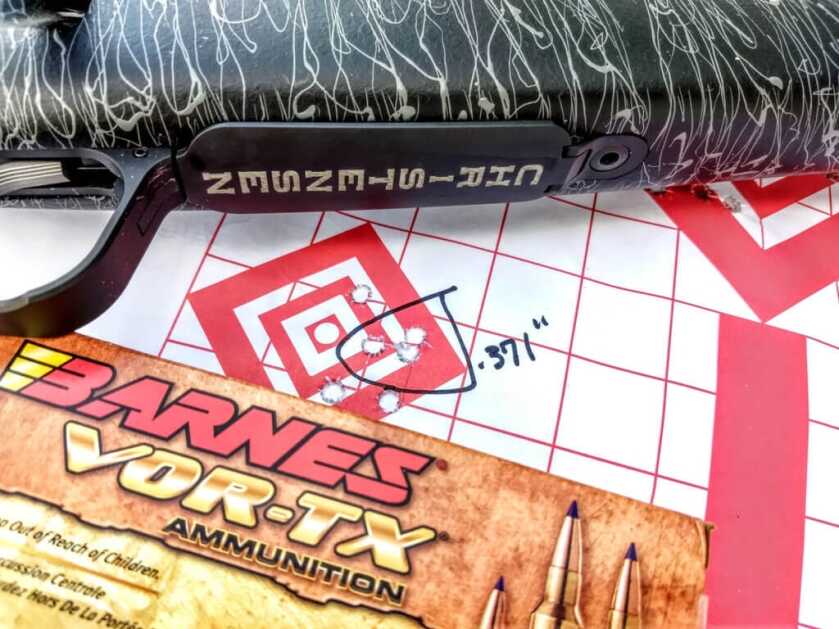
The Hornady Full Boar printed a very respectable five shot groups of approximately 1.25-inches.
I have no heat measuring devices to scientifically verify this, but my observation was the Christensen Ridgeline’s carbon fiber wrapping allows the barrel to cool down to ambient temperature in about half the time required for a traditional steel barrel.
To build the Ridgeline’s barrel, Christensen starts with a 416R stainless-steel liner that is button rifled and has a bore tolerance of +/- .0001. Next, Christensen applies a proprietary carbon-fiber layering design to harness the strength and heat-conducting benefits of carbon fiber. The liner-plus-carbon wrapping provides for more consistent barrel harmonics and better accuracy, as well as a barrel that cools off rapidly.
It also looks pretty cool—to this hunter, at least.
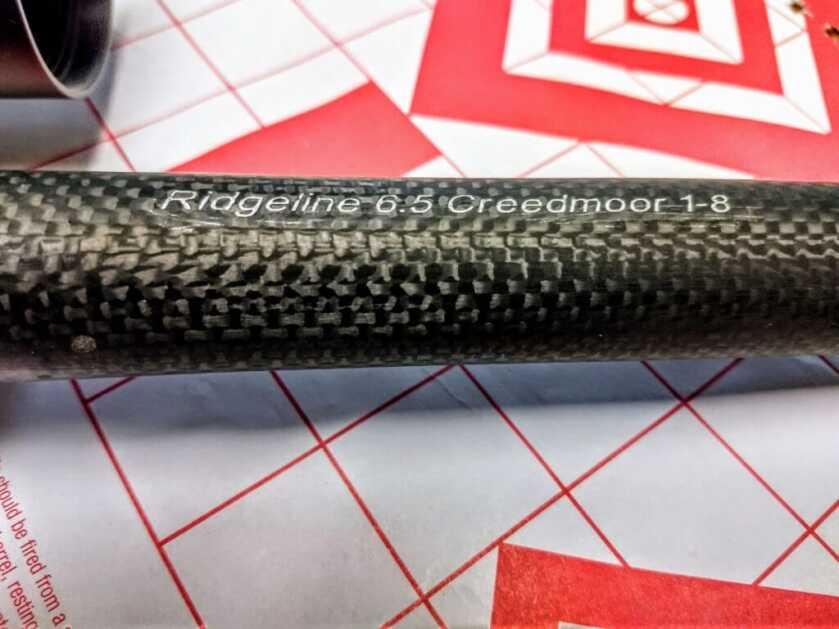
My Ridgeline has a 24-inch barrel; it’s also available with a 20-inch barrel. Depending on the caliber, Ridgeline barrel lengths range from 20 to 26-inches. Rifling is a 1:8 LH twist. All Ridgelines come standard with a TriggerTech Remington 700 Primary Trigger, adjustable by the user from 1.5 to 4.0-pounds of pull. Mine measured at an even 2.0-pounds of pull, according to my Lyman Digital Trigger Pull Gauge. The trigger breaks very, very cleanly, has zero creep, and resets quickly. If you pull a shot with this rifle? It won’t be because of the trigger.
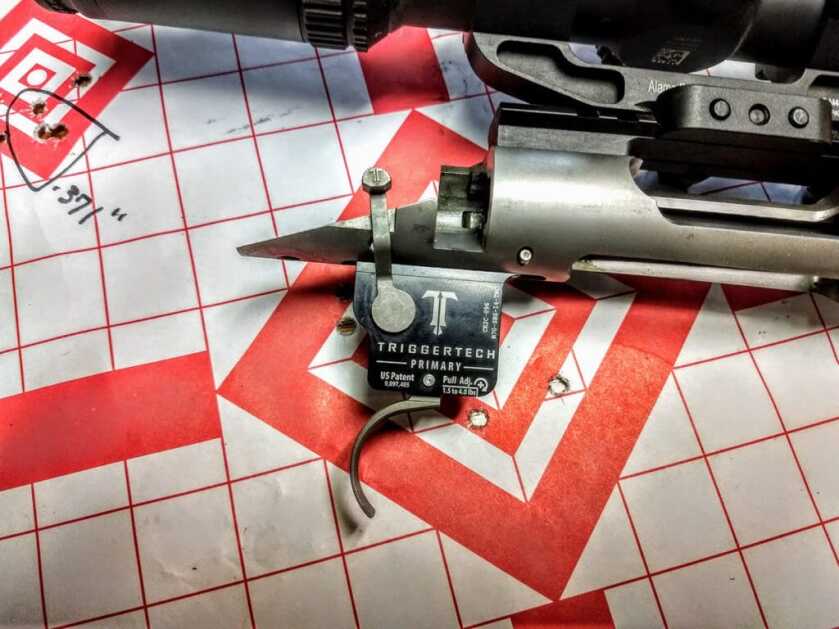
The Ridgeline’s spiral-fluted bolt features two beefy, stainless steel lugs that measured .443-inches across the top; they worked smoothly and locked up into the chamber very tightly. The bolt itself is nitride-treated. It also employs an M16-Style extractor which flings the empty brass out a good six feet. (Magnum caliber Ridgeline models have dual ejectors.) The bolt knob is fluted and provides a very positive grip for the shooter, while the rifle’s receiver is built with an enlarged ejection port.
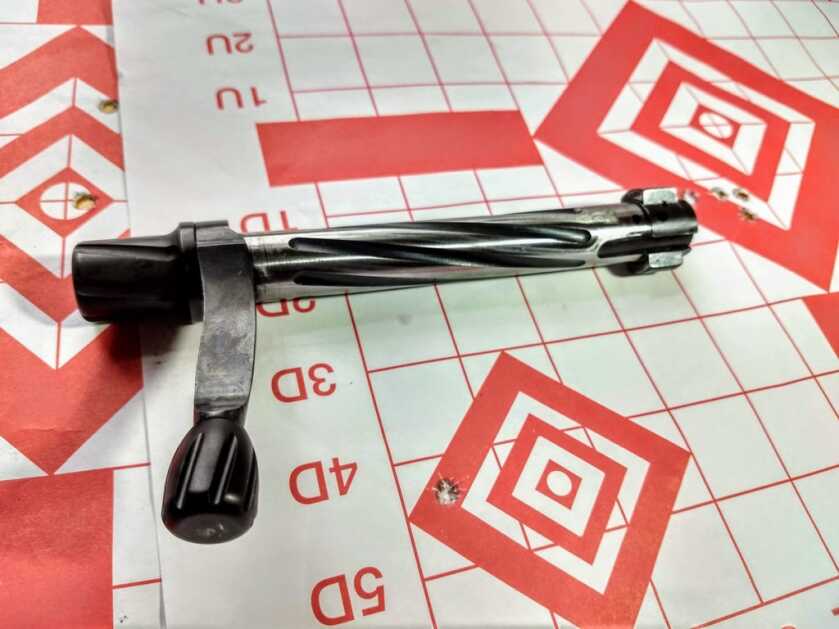
The threaded barrel comes with a stainless-steel thread protector, plus a Christensen muzzle brake.
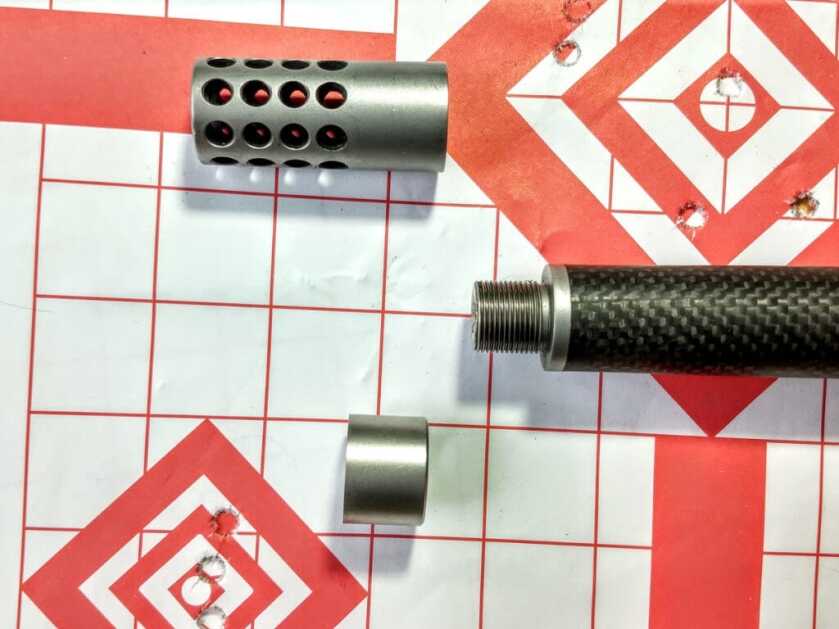
The Ridgeline’s sporter-style carbon fiber composite gunstock is handsomely done, with a topcoat of swirling paint lines over a black background. The surface of the stock also provides a nice grippy feel, even with the stock is cold or wet.

All in all, the Christensen Arms Ridgeline is a first-rate hunting rifle, and at just a shade over six pounds won’t be a burden to carry even on backcountry hunts. No, it doesn’t cost $450. Much closer to $2,000, though the Internet has a couple of dealers offering it for right at $1,800. That’s a substantial amount of money—and for that investment, a shooter receives a substantial and extremely functional rifle.

*Velocities measured with a PACT Professional XP Chronograph, from Brownell’s, unit approximately six-feet from the rifle muzzle. Average of ten shots per ammunition brand.
Specs: Christensen Arms Ridgeline
- Caliber (as tested): 6.5 Creedmoor
- Capacity: 4 Rounds
- Action: Bolt, two-lug, fluted bolt
- Barrel: Carbon-fiber wrapped over a stainless-steel liner, free-floating, threaded
- Barrel Length: 24”
- Rifling: 1:8 LH
- Trigger: Match-grade, adjustable TriggerTech Primary
- Sights: None, drilled and tapped for optics
- Stock: Carbon Fiber Composite
- Overall Length: 43.5”
- Weight (unloaded): 6.3 Lbs.
- Misc: Backed by the Christensen Arms Sub-MOA Guarantee.
- MSRP: $1,995.00
Learn more by visiting ChristensenArms.com.
Buy a Ridgeline on GunsAmerica.
Tested: Trijicon AccuPower 4-16×50 Rifle Scope
For my time spent hunting with and testing the Ridgeline, I used a Trijicon AccuPower 4-16×50 scope. The glass is very clear, pulling in more than enough light for a hunter to take an accurate and ethical shot into dusk and beyond. Images seen through the AccuPower are very sharp, the colors crisp and the edges nicely defined even at distances past 300 yards.
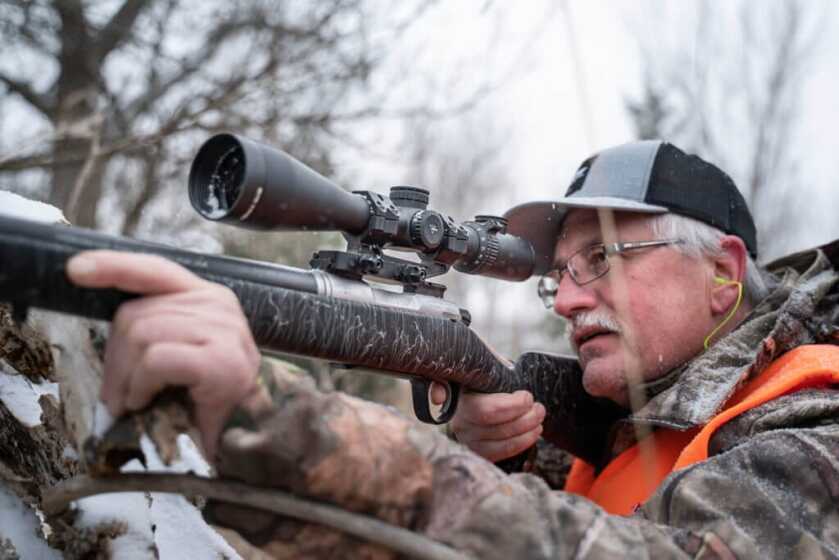
The ¼ MO per-click adjustments are precise. During my accuracy testing of the rifle, I switched ammunition brands and my first three shots at 100 yards printed approximately ¾’s of an inch to the right and 1-inch high. Three clicks to the left and four down and I was right on the bullseye.
The AccuPower 4-16×50 is available with three different reticle options: Duplex Crosshair; MIL-Square crosshair; and MOA crosshair. All are LED illuminated and are powered by a single CR 2032 lithium battery.
I used the MOA crosshair, which features angled lines coming down off the center crosshair that allow a shooter to hold to the right or left for the wind. These lines even provide windage hold points at the bullet drop holdover distances, too.
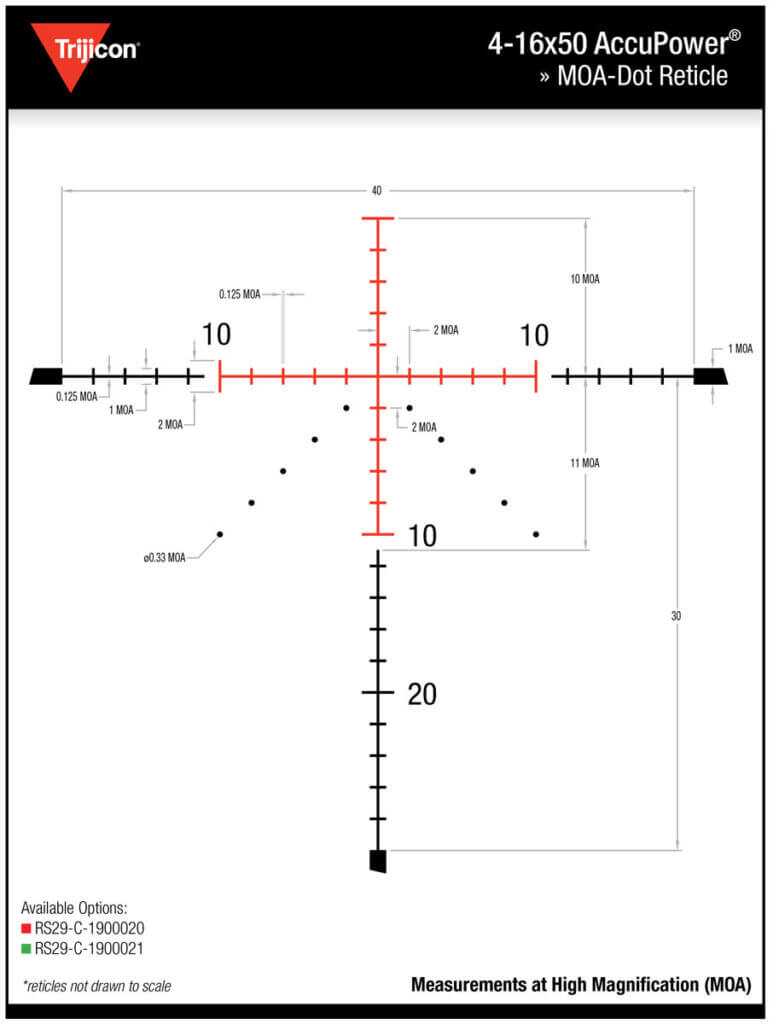
When set at 16x magnification, the MOA Crosshair reticle can be used as a BDC reticle, too, once the rifle and load are plugged into a ballistic calculator and the shooter knows exactly where the holdovers should be with the 2 MOA tick mark crosshair. Alternatively, the MOA reticle pattern can be used to size and range a target.
The LED reticle illumination comes in either red or green. The 30mm tube is made of tough 6061-T6 aluminum.
All in all, I rate the Trijicon AccuPower 4-16×50 as a near-perfect hunting scope out to 500 yards.
Specs: Trijicon AccuPower 4-16×50 Rifle Scope
Magnification: 4-16x
Objective Size: 50mm
Weight: 23.3 oz.
Length: 14”
Illumination Source: 1 CR2032 Lithium Battery
Battery Life: 31 hours at max brightness
Reticle Pattern: MOA-DOT Crosshair (as tested)
Eye Relief: 3.6” – 3.7”
Exit Pupil: 0.37” – 0.12”
Field of View @ 100 yards: 25.8 to 6.4 ft.
Adjustment @ 100 yards: 1/4 MOA per click
Tube Size: 30mm.
Tube Housing: 6061-T6 aluminum, anodized, black hard-coat finish
Adjustment Range: 80 MOA Total Travel
Waterproof: To 10ft.
Parallax Adjustment Range: 10yds. to Infinity
MSRP: $999.00 www.trijicon.com


Love my 6.5prc with a leupold vac-6 3×18 with custom torrent for Hornsby precision hunter . Never had a gun that shot like this . 600 yards today. Just crank to to the 60 yard mark and I laugh every time I pull the trigger. Best rifle I ever owned. Period
I see typo’s in my prev post, it is 300 PRC..
I couple of things, I am going to give this guy the benefit of doubt, it looks like the 2nd pic was a selfie using a tripod and timer, maybe he didn’t have time to properly get set up.. as you can see the rifle is also tilted..
As for the larger scopes.. When you get older your eyes age also, it is harder to see at dusk/dawn without the large objective. I am facing that same situation myself. I have a 44mm objective on a ruger rifle, that barely cuts it for me now.
With that being said, I do agree the scope rings are too high, he would have better cheek weld with lower rings and probably smaller groups. I have a Christensen arms ELD in 330 PRC, it comes with an adjustable cheek weld, but even after adding all the spacers, it was still too low.. not proper cheek weld, so i added a godagrip stick on cheek piece, that 1) is soft so it cushions when I am shooting and 2) it gives me that little extra height i needed. With that being said, I did go through 3 different set of rings and my scope only has a clearance of about 2mm.. it is a NF with a 56 objective. I plan on using the gun for hunting, but also for PRS shooting. It is multi purpose for me.
I will finally add, I will no longer buy a rifle with a stock that doesn’t have a cheek riser. If I go to a prone position, it is very difficult for me to get a proper cheek weld. I looked at the ridgeline models, but decided to just go with the ELR, it adds a little weight, but a proper set up for me is worth the weight.
Normally I enjoy the content from GunsAmerica and Hunt365. I have to say this article is one that should be scrapped if you want to maintain credibility with shooters who know how to set up a rifle. Worse, uneducated shooters come to expect quality instruction on equipment set up/shooting technique and this article DOES NOT portrait either. It is very clear the author is NOT knowledgeable on either. Chistensen Arms deserves better too.
The caption under one of the photos describes the rifle as a 500 yard hunter. This statement is a bit of a misnomer, because when a hunter sees a game animal at 500 yards the hunt is just beginning. For a hunter, it is disheartening to see so many product manufacturers marketing products to allow folks to kill game at longer and longer ranges. For the good of the sport of hunting I think marketing this rifle as “A lightweight hunter”, instead of marketing it as a long range killer, would be much better.
It’s a nice rifle, but for $2,000 it should shoot a lot better than 1.0 MOA. Plus that very nice scope is mounted much too high.
Agreed, my Remington 700 in 7mm mag shoots sub MOA all day long with a variety of factory ammo, it is rather partial to Reminton Premier Accu tip150 gr though. It’s 50 year anniversary edition but other than that and a Timney trigger it’s a stock rifle with many hours in the field on mules bangginng around in the Ranger and being drug along the ground sneaking into position for a shot on uncle Buck. and oh yea I bought it used and had it shipped accross the nation.
Leupold 4-12 w/ Boon and Crocket reticle.
Whole set up $1,600.00
I’m sure it does if the scope is attached correctly and the shooter uses correct, repeatable shooting technique. The scope is so high (mounted with an AR cantilever mount) that there is ZERO percent chance the author can have a repeatable cheek weld. Which means accuracy will definitely suffer.
Highly unlikely I’m ever going to buy a two grand rifle and put another grand in its scope. Still, I like reading about these things.
However, it is also kinda nice to consider that my Weatherby Vanguard (Howa) .308–with budget scope—is capable of essentially the same performance. Heheh.
Gosh dang it BRIAN!!! 2wks ago I read Kat’s handgun hunting article and told her, “between YOU and Brian, my bank accounts (and lack of will power) do not like you!” lol I have been looking in to the CA Ridgline in 6.5CM for a [lighter skinned/boned] game backcountry rifle for some time. I’ve been trying to talk myself out of it, “You can go without it and use that cash for…” but, then you two pop up in my emails! Two write ups to drool over (more than usual) in 2wks…that’s just not fair 😉 Great article my friend! Keep stacking em up!!!
The first thing that caught my eye is this fool doesn’t have a clue how to mount and use a scope. Look at the stock. There is no cheek piece, so it is designed for a small objective lightweight scope mounted close to the barrel. You have a tail wagging the dog sight system. A big heavy scope mounted too high over a wonderful lightweight rifle. A 2-7X32 Leupold mounted in 4 screw weaver light weight rings would be a better choice.
The second thing is that the shooters face does not contact the stock. There is no “cheek weld”.
As a former hunter safety instructor, I do not like to see “match” bullets, not designed for big game, encouraged for use at long range. The 6.5 Creedmore at 2600 fps does not have enough energy at that range (300yards plus) to be consistently lethal. We owe our quarry to make better choices and not mislead the next generation of potential hunters.
good eye and you are very right. the optic looks like it belongs on a AR
Not sure why the average hunter would spend $1800 – $2000 for a rifle that doesn’t shoot any better than a $350 Ruger or TC.
I don’t understand why so many people mount their gigantic optics so high above the barrel. In the two pictures in the article which show the shooter aiming the rifle, you can see that there is no solid cheek weld to the stock; he is raising his head up so he can see through the scope. You can also see that there is what looks to be over an inch between the front bell of the scope and the rifle’s barrel, so there is certainly plenty of opportunity to use lower mounts and get the scope closer to the gun. Yeah, you took a standing doe at 320 yards under ideal conditions, but I think you’re doing the gun a disservice by mounting the scope so high. My opinions only sir.
In most hunting situations you’re right. However for long distance only, a higher scope will require less holdover.
You are one hundred percent correct,I don’t care what excuse these guys give, the closer the scope is to the axis of the bore the better off you are.. period, this is supposed to be a hunting rifle not a match chassis set up.